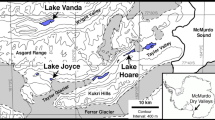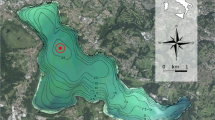Abstract
Cyanobacteria are fundamental components of aquatic phytoplankton communities and some taxa can cause harmful blooms in coastal ecosystems. Harmful cyanobacterial blooms are typically comprised of multiple strains of a single genus or species that cannot be resolved microscopically. Florida Bay, USA, has experienced harmful cyanobacterial blooms that have been associated with the loss of eelgrass, spiny lobsters, and general food web disruption for more than two decades. To identify the strain or strains of cyanobacteria forming blooms in Florida Bay, samples were collected across the system over an annual cycle and analyzed via DNA sequencing using cyanobacterial-specific 16S rRNA gene primers, flow cytometry, and scanning electron microscopy. Analyses demonstrated that the onset of blooms in Florida Bay was coincident with a transformation of the cyanobacterial populations. When blooms were absent, the cyanobacterial population in Florida Bay was dominated by phycoerythrin-containing Synechococcus cells that were most similar to strains within Clade III. As blooms developed, the cyanobacterial community transitioned to dominance by phycocyanin-containing Synechococcus cells that were coated with mucilage, chain-forming, and genetically most similar to the coastal strains within Clade VIII. Clade VIII strains of Synechococcus are known to grow rapidly, utilize organic nutrients, and resist top-down control by protozoan grazers and viruses, all characteristics consistent with observations of cyanobacterial blooms in Florida Bay. Further, the strains of Synechococcus blooming in this system are genetically distinct from the species previously thought to cause blooms in Florida Bay, Synechococcus elongatus. Collectively, this study identified the causative organism of harmful cyanobacterial blooms in Florida Bay, demonstrates the dynamic nature of cyanobacterial stains within genera in an estuary, and affirms factors promoting Synechococcus blooms.






Similar content being viewed by others
References
O'Neil JM et al (2012) The rise of harmful cyanobacteria blooms: the potential roles of eutrophication and climate change. Harm Algae 14:313–334
Huang S et al (2012) Novel lineages of Prochlorococcus and Synechococcus in the global oceans. Isme j 6(2):285–97
Fuller NJ et al (2003) Clade-specific 16S ribosomal DNA oligonucleotides reveal the predominance of a single marine Synechococcus clade throughout a stratified water column in the Red Sea. Appl Environ Microbiol 69(5):2430–43
Davis TW et al (2009) The effects of temperature and nutrients on the growth and dynamics of toxic and non-toxic strains of Microcystis during cyanobacteria blooms. Harm Algae 8(5):715–725
Paerl and Paul, 2012.
Fourqurean JW, Robblee MB (1999) Florida Bay: a history of recent environmental changes. Estuaries 22:345–357
Sunda WG, Graneli E, Gobler CJ (2006) Positive feedback and the development and persistence of ecosystem disruptive algal blooms. J Phycol 42(5):963–974
Phlips EJ, Badylak S, Lynch TC (1999) Blooms of the picoplanktonic cyanobacterium Synechococcus in Florida Bay, a subtropical inner-shelf lagoon. Limnol Oceanogr 44(4):1166–1175
Goleski JA et al (2010) The role of zooplankton grazing and nutrient loading in the occurrence of harmful cyanobacterial blooms in Florida Bay. USA Estuaries and Coasts 33(5):1202–1215
SERC (1989–2008) Southeast Environmental Research Center, Water Quality Monitoring Network annual data reports
Wall CC et al (2012) Responses of loggerhead sponges Spechiospongia vesparium during harmful cyanobacterial blooms in a sub-tropical lagoon. Mar Ecol Prog Ser 451:31–43
Phlips EJ, Badylak S (1996) Spatial variability in phytoplankton standing crop and composition in a shallow inner-shelf lagoon, Florida Bay. Florida Bull Marine Sci 58(1):203–216
Hall MO et al (1999) Decadal changes in seagrass distribution and abundance in Florida Bay. Estuaries 22(2B):445–459
Chasar LC et al (2005) Evaluating the effect of environmental disturbance on the trophic structure of Florida Bay, USA: Multiple stable isotope analyses of contemporary and historical specimens. Limnol Oceanogr 50(4):1059–1072
Drummond, A.J., et al., Geneious v5.5. Available from http://geneious.com, 2010.
Olson, R.J., et al., Advances in oceanography through flow cytometry. In Particle Analysis in Oceanography, 1991. ed. S. Demers: p. 351–399 Berlin: Springer - Verlag.
Jochem FJ (2001) Morphology and DNA content of bacterioplankton in the northern Gulf of Mexico: Analysis by epifluorescence microscopy and flow cytometry. Aquat Microb Ecol 25(2):179–194
Dempster EL et al (1999) Rapid DNA extraction from ferns for PCR-based analyses. Biotechniques 27(1):66–8
Nubel U, Garcia-Pichel F, Muyzer G (1997) PCR primers to amplify 16S rRNA genes from cyanobacteria. Appl Environ Microbiol 63(8):3327–32
Tkavc R et al (2011) Bacterial communities in the ‘petola’ microbial mat from the Sečovlje salterns (Slovenia). FEMS Microbiol Ecol 45:48–62
Allen JP et al (2007) The microbial community structure in petroleum-contaminated sediments corresponds to geophysical signatures. Appl Environ Microbiol 73(9):2860–2870
Waterbury JB et al (1986) Biological and ecological characterization of the marine unicellular cyanobacterium Synechococcus. Can Bull Fish Aquat Sci 214:71–120
Moore LR, Goericke R, Chisholm SW (1995) Comparative physiology of Synechococcus and Prochlorococcus—Influence of light and temperature on growth, pigments, fluorescence and absorptive properties. Mar Ecol Prog Ser 116(1–3):259–275
Zwirglmaier K et al (2009) Differential grazing of two heterotrophic nanoflagellates on marine Synechococcus strains. Environ Microbiol 11(7):1767–76
Scanlan DJ et al (2009) Ecological genomics of marine picocyanobacteria. Microbiol Mol Biol Rev 73(2):249–99
Anderson SL, McIntosh L (1991) Light-activated heterotrophic growth of the cyanobacterium Synechocystis sp. strain PCC 6803: a blue-light-requiring process. J Bacteriol 173(9):2761–7
Schubert H et al (1995) Blooming of Cyanobacteria in Turbulent Water with Steep Light Gradients—the effect of intermittent light and dark periods on the oxygen evolution capacity of Synechocystis Sp Pcc-6803. Fems Microbiol Ecol 18(3):237–245
Campbell L, Carpenter EJ, Iacono VJ (1983) Identification and enumeration of marine chroococcoid cyanobacteria by immunofluorescence. Appl Environ Microbiol 46(3):553–9
Evans SL, Anderson WT, Jochem FJ (2006) Spatial variability in Florida Bay particulate organic matter composition: combining flow cytometry with stable isotope analyses. Hydrobiologia 569:151–165
Glibert PM et al (2004) Evidence for dissolved organic nitrogen and phosphorous uptake during a cyanobacterial bloom in Florida Bay. Marine Ecology - Progress series 280:73–83
Peterson BJ et al (2006) Potential role of sponge communities in controlling phytoplankton blooms in Florida Bay. Mar Ecol Prog Ser 328:93–103
Anderson DM et al (2008) Harmful algal blooms and eutrophication: Examining linkages from selected coastal regions of the United States. Harm Algae 8(1):39–53
Smayda TJ (1997) Harmful algal blooms: Their ecophysiology and general relevance to phytoplankton blooms in the sea. Limnol Oceanogr 42(5):1137–1153
Lennon JT et al (2007) Is there a cost of virus resistance in marine cyanobacteria? Isme J 1(4):300–312
Paerl HW (1991) Ecophysiological and trophic implications of light-stimulated amino acid utilization in marine picoplankton. Appl Environ Microbiol 57:473–479
Boyer JN et al (2006) The role of dissolved organic matter bioavailability in promoting phytoplankton blooms in Florida Bay. Hydrobiologia 569:71–85
Li H, Veldhuis MJW, Post AF (1998) Alkaline phosphatase activities among planktonic communities in the northern Red Sea. Marine Ecol - Progress series 173:107–115
Caron DA et al (1991) Grazing and utilization of Chroococcoid Cyanobacteria and Heterotrophic Bacteria by Protozoa in laboratory cultures and a Coastal Plankton Community. Mar Ecol Prog Ser 76(3):205–217
Buskey EJ et al (1997) Disruption of grazer populations as a contributing factor to the initiation of the Texas brown tide algal bloom. Limnol Oceanogr 42(5):1215–1222
Liu HB, Buskey EJ (2000) The exopolymer secretions (EPS) layer surrounding Aureoumbra lagunensis cells affects growth, grazing, and behavior of protozoa. Limnol Oceanogr 45(5):1187–1191
Strom SL (2008) Microbial ecology of ocean biogeochemistry: a community perspective. Science 320(5879):1043–5
Beardall J et al (2009) Allometry and stoichiometry of unicellular, colonial and multicellular phytoplankton. New Phytol 181(2):295–309
Jiang X, Lonsdale DJ, Gobler CJ (2010) Grazers and vitamins shape chain formation in a bloom-forming dinoflagellate. Cochlodinium polykrikoides Oecologia 164(2):455–464
Long JD et al (2007) Chemical cues induce consumer-specific defenses in a bloom-forming marine phytoplankton. Proc Natl Acad Sci U S A 104(25):10512–7
Lu J (2001) F. Chen, and R.E. Hodson, Distribution, Isolation, Host Specificity, and Diversity of Cyanophages Infecting Marine Synechococcus spp. in River Estuaries. Appl Environ Microbiol 67:3285–3290
Acknowledgments
We thank Dr. Timothy Davis, Dr. Theresa Hattenrath-Lehmann, Dr. John Caroll, and Dr. Tom Frankovich, and Brooke Rodgers for field and laboratory assistance. Funding for this project was provided by the NOAA South Florida program. This is Lamont-Doherty Earth Observatory Contribution Number 0000. This is SoMAS Contribution Number 0000.
Author information
Authors and Affiliations
Corresponding author
Rights and permissions
About this article
Cite this article
Berry, D.L., Goleski, J.A., Koch, F. et al. Shifts in Cyanobacterial Strain Dominance during the Onset of Harmful Algal Blooms in Florida Bay, USA. Microb Ecol 70, 361–371 (2015). https://doi.org/10.1007/s00248-014-0564-5
Received:
Accepted:
Published:
Issue Date:
DOI: https://doi.org/10.1007/s00248-014-0564-5




